The Bighorn River In Summer -- Fly Fishing At It's Best
The Bighorn River In Summer -- Fly Fishing At It's Best
By Bob Krumm
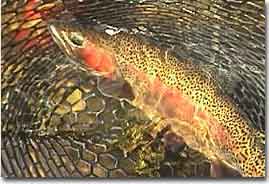 "If ever I would leave you, it wouldn't be in summer, Seeing you in summer I never would go." So goes the opening verse in a song from Camelot. Since I sing a lot, especially when I'm happy, I sing an awful lot (much to my anglers' dismay) when I'm guiding on the Bighorn River during the summer. "If ever I would leave you, it wouldn't be in summer, Seeing you in summer I never would go." So goes the opening verse in a song from Camelot. Since I sing a lot, especially when I'm happy, I sing an awful lot (much to my anglers' dismay) when I'm guiding on the Bighorn River during the summer. Why not sing? If I see beauty and serenity about me and so much to appreciate, it's a natural reaction to be inspired. My God, all that you have prepared for me to enjoy: big, white fluffy clouds floating in a deep blue sky, swallows skimming the water, flocks of ducks and geese feeding in the shallows, sandhill cranes flying over trumpeting their unique clarion call, red-headed woodpeckers flashing their strikingly white and black colors as they wing by, coneflowers blossoming in profusion along the banks, and chokecherries and buffaloberries growing ripe in the hot sun. Why it seems that there are at least two or three brief thunder showers a week in the afternoons that produce some of the most vivid rainbows God ever imagined. Speaking of rainbows, summer time on the Bighorn River brings those magnificent fish to the surface to feast on the bountiful insect hatches that July and August produce. Of course, the brown trout are up and at 'em, too, but some of my favorite summer memories are of big rainbow trout tucked away in pockets along brushy banks slowly rising to crippled pale morning duns or crippled yellow sallies. The rainbows in such situations always pose a challenge to my anglers. There are problems with getting an accurate cast into an area the size of a kitchen sink. There are problems with getting a drag free float, especially since the fish is resting in calm water and just taking insects off the inside edge of the feed line. The proper pattern, the proper approach and stalk add further complications to this pulse raising game of life and death (the fish doesn't know that he or she will be put back--anytime a fish is hooked, the fish is literally fighting for its life). Yes, summer time is not the time to leave the Bighorn River for so much is happening. In my estimation the best fly hatches occur during the months of July and August. In early July the yellow sallies ( a small, yellow stonefly) start hatching on the lower river. Simultaneously, the pale morning duns appear. Toward the end of July, the black caddis appear in phenomenal numbers. In mid August the sedge caddis start and, by the end of the month, the tricos appear. The yellow sally is a size 14 (plus or minus a size) stonefly that inhabits the riffles and runs of the Bighorn. It hatches mid day--a real break for lazy anglers and guides--usually in fairly shallow water. The trout will move into these waters and go after the emerging and adult stoneflies with a vengeance. As the adult stoneflies are skittering across the surface trying to get airborne, the trout take them dramatically. Toilet flushes, a ten pound bag of sugar dropped into the water, and a grasshopper take are comparable analogies. 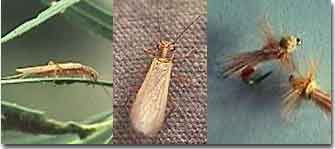 Probably the best dry fly fishing for yellow sallies comes later in the day as the trout cruise looking for the crippled and spent sallies. The rises will be very sporadic, but if you can get a cast close to the rise within five seconds or so, you stand a relatively good chance of hooking a trout. Probably the best dry fly fishing for yellow sallies comes later in the day as the trout cruise looking for the crippled and spent sallies. The rises will be very sporadic, but if you can get a cast close to the rise within five seconds or so, you stand a relatively good chance of hooking a trout. I find that about any yellow sally pattern will get the job done, but I prefer a size 14 thorax tie. I dub on some red rabbit for a tag or butt, then dub some light yellow on to cover about 2/3 the shank. Then I add a sparse wing of bleached elk hair, measured to be no more than the length of the hook. I tie in a light ginger hackle, get eight or so wraps, tie it off and clip it. Then I spin on some more yellow dubbing and wrap it. When I start to take the dubbing under the hook, I bring the dubbing back behind the hackle, lift up the hackle with the dubbing, go over the top of the hook behind the hackle and when I start to go under, come forward. I repeat the previous two steps. In this way I have created an "X" with the dubbing under the fly and lifted up the hackle so that the fly sits flat on the water. Of course, the yellow sally hatch isn't the only show in town. If you have ever fished a good pale morning dun hatch, you know what an exciting mayfly hatch is all about. The Bighorn River has varying degrees of PMD hatches. Last year's hatch on a scale from one to ten was a six. Since we didn't have outrageous high water last year, I would suspect that 1999's PMD hatch will be a seven or eight. 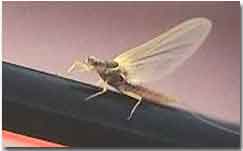 One species of PMD hatches in the Bighorn River during July: Ephemerella infrequens. It is a size 14--16 mayfly with a orangish yellow abdomen. Normally, the hatch occurs in the late morning hours and lasts for at least two hours. Of course, the cripples will remain until they are either eaten or swept into a pile of detritus. One species of PMD hatches in the Bighorn River during July: Ephemerella infrequens. It is a size 14--16 mayfly with a orangish yellow abdomen. Normally, the hatch occurs in the late morning hours and lasts for at least two hours. Of course, the cripples will remain until they are either eaten or swept into a pile of detritus. The trout seem to prefer the cripples in this hatch. In my opinion, about one quarter of the emergers become cripples--especially on a windy day. These large winged mayflies have a rough time getting off the water when the wind is blowing. Suffice it to say, a good PMD cripple pattern will get the job done during the PMD hatch, but on windy days, it is even more effective. Toward the end of the July the black caddis really get with the program. These size 18 caddis emerge around four or five in the afternoon. If you are a wet fly fisherman, this is the time to be on the river. A black caddis emerger pattern cast quartering upstream across a riffle will result in some wrenching strikes. 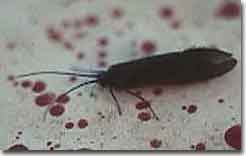 Later on in the day the female caddis begin their egg laying activities. Since the female doesn't have enough umph in her ovipositor to break the water surface film, she must land on an object protruding from the water, crawl down the object into the water, and lay her eggs. What this translates into for the angler are hordes of black caddis crawling all over you as you are trying to fish at this time. If you don't like a creepy, crawly feeling on your arms, don't wear a short sleeved shirt, button the top button of your shirt and don't take deep breaths. If you talk much, you can bet that you will eat a couple black caddis in the course of your conversation. Later on in the day the female caddis begin their egg laying activities. Since the female doesn't have enough umph in her ovipositor to break the water surface film, she must land on an object protruding from the water, crawl down the object into the water, and lay her eggs. What this translates into for the angler are hordes of black caddis crawling all over you as you are trying to fish at this time. If you don't like a creepy, crawly feeling on your arms, don't wear a short sleeved shirt, button the top button of your shirt and don't take deep breaths. If you talk much, you can bet that you will eat a couple black caddis in the course of your conversation. I have found that the trout are really looking for these egg laying female caddis. Those caddis that get swept away by the water while crawling down an object are usually trout chow in a millisecond. Those caddis that manage to lay their eggs, let go of their hold, and float back to the surface. Again they are gobbled. The spent caddis on the surface offer still more trout feeding opportunities. A number 18 black CDC caddis at this time will be a killer. There are places on the Bighorn where the trout are feeding so heavily on the spent caddis that it looks like feeding time at a hatchery. In fact, one spot below a downed tree I have named "the hatchery." In August, I often will pass the daylight hours by having my anglers fish the banks with grasshopper or ant patterns. If we are floating, the hopper pattern is much more effective, but if the clients are wade fishing a grassy bank, ants can be the ticket. As September approaches tricos make their appearance. This mayfly starts hatching in the wee hours of the morning. Many anglers will stake out a spot to fish in total darkness so that they can fish this hatch at first light. I guess that's a good strategy for those people that are morning people, but I find that the spinner fall usually occurs around 10 to 11 each day. The trout feed just as voraciously on the spinner fall and I am able to get a good night's sleep. Bighorn River tricos are usually a size 18--20 mayfly. The abdomen is light olive and the thorax, black. I find that a size 18 H&L variant makes a great imitation of the dun. I will often use the H&L as an indicator when I'm fishing the spinner fall. 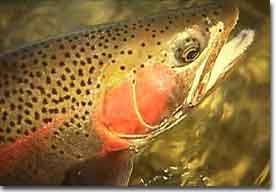 It is during the trico spinner fall that I often see the year's best feeding pods of trout. It is not unusual to see 30 to 50 trout in a pod feeding like a herd of pigs at a trough. It is during the trico spinner fall that I often see the year's best feeding pods of trout. It is not unusual to see 30 to 50 trout in a pod feeding like a herd of pigs at a trough. Throughout the summer and fall there are plenty of gray days and stormy afternoons. These days are ideally suited for streamer fly fishing. Matukas, bucktails, Clousers, and wooly buggers are all effective at these times. Never pass up a chance to get a truly big fish--take along your favorite streamers! Well, I have only briefly touched why I would never the leave the Bighorn River in the summer. I could write about a lot of other reasons to fish the Bighorn in the summer, suffice it to say, once you do fish the Bighorn in the summer, you'll never want to leave. ~ Bob Krumm
|
